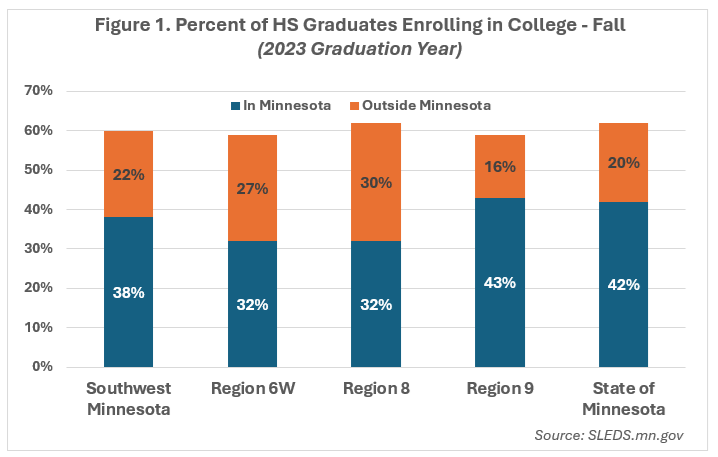 Southwest Minnesota is a national leader in agricultural production, and renewable energy.
Southwest Minnesota is a national leader in agricultural production, and renewable energy.
The region's thriving manufacturing sector includes food processing, machinery, printing, metal products, and computers and electronic products.
Want the freshest data delivered by email? Subscribe to our regional newsletters.
With another school year about to start, workforce development professionals might be curious about what happens to past students.
8/27/2025 10:57:58 AM
Amanda Blaschko, Luke Greiner
With another school year about to start, workforce development professionals might be curious about what happens to past students. The Minnesota Statewide Longitudinal Education Data System (SLEDS) links student data from pre-kindergarten through postsecondary education and into the workforce, providing a comprehensive view of how education connects to career outcomes.
One set of SLEDS data shows the percent of high school graduates that enroll in college in the fall after graduation. In recent years, just over 60% of students in Southwest Minnesota have chosen that path, which is in line with the rest of the state, where 62% went immediately into college. However, the share that go, and where they go, varies by economic development region and school district. For example, nearly one-third of graduates in both Region 6W and Region 8 go to college in Minnesota, while 43% of students from Region 9 stay in Minnesota (Figure 1).

Not only location, but graduates also differ in what type of college they attend. In comparison to the state as a whole, a larger percentage of graduates in Southwest Minnesota chose a 4-year state university or 2-year state college, while regional graduates were much less likely to attend a private 4-year university. With close proximity to South Dakota and Iowa, Southwest also had a higher share that went outside Minnesota for college (Figure 2).

The SLEDS data even shows which colleges students are most likely to attend. Minnesota State University-Mankato is the biggest draw for local students, attracting 330 students from the 2023 graduation year in the fall immediately following graduation. Other popular postsecondary institutions for graduates from the region include South Central College, Minnesota West Community & Technical College and Southwest Minnesota State University. But the region also sends lots of students to out of state colleges and universities, including South Dakota State, Lake Area Tech, Southeast Tech and North Dakota State, and retaining these students after they attend and eventually graduate from college is a big opportunity for the region (Table 1).
| Table 1. Number of Students from Southwest Minnesota Enrolling in College the Fall After Graduation, 2023 | |||
|---|---|---|---|
| Institution | State | Number of Students | Percent |
| Minnesota State University-Mankato | MN | 330 | 14.0% |
| South Central College | MN | 202 | 8.6% |
| South Dakota State University | SD | 200 | 8.5% |
| Minnesota West Community & Technical College | MN | 197 | 8.4% |
| Southwest Minnesota State University | MN | 130 | 5.5% |
| University of Minnesota-Twin Cities | MN | 122 | 5.2% |
| Ridgewater College | MN | 80 | 3.4% |
| Lake Area Technical College | SD | 69 | 2.9% |
| Winona State University | MN | 59 | 2.5% |
| Southeast Technical College | SD | 58 | 2.5% |
| North Dakota State University | ND | 51 | 2.2% |
| Alexandria Technical & Community College | MN | 45 | 1.9% |
| Gustavus Adolphus College | MN | 44 | 1.9% |
| University of Minnesota-Duluth | MN | 38 | 1.6% |
| Augustana University | SD | 37 | 1.6% |
| Source: SLEDS.mn.gov | |||
For more information about graduate employment outcomes in Southwest Minnesota, contact Luke Greiner at Luke.Greiner@state.mn.us or Amanda Blaschko at Amanda.Blaschko@state.mn.us.